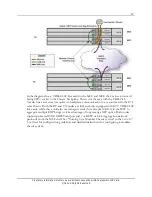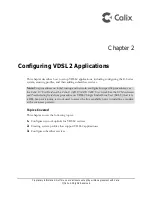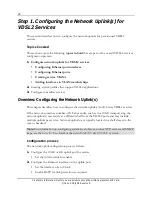
20
Proprietary Information: Not for use or disclosure except by written agreement with Calix.
© Calix. All Rights Reserved.
Step 1. Configuring the Network Uplink(s) for
VDSL2 Services
This section describes how to configure the network uplinks for provisioned VDSL2
services.
Topics Covered
This section covers the following
topics in bold
that are part of the overall VDSL2 services
configuration process:
1.
Configure network uplinks for VDSL2 services
Configuring Ethernet port interfaces
Configuring Ethernet ports
Creating service VLANs
Adding interfaces to VLAN memberships
2.
Creating system profiles that support VDSL2 applications
3.
Configure subscriber services
Overview: Configuring the Network Uplink(s)
This chapter describes how to configure the network uplink(s) for E-Series VDSL2 services.
If the network contains a number of E-Series nodes, such as in a 10GE transport ring, the
network uplink(s) may reside in a different shelf from the VDSL2 ports and may include
multiple uplinks per service. Network uplink(s) are typically located in a shelf closest to the
core or headend.
Note:
For information on configuring system-level objects, such as NTP servers and SNMP
traps, see the
Calix E7 User Guide
or the
Calix E3-48/E5-48/E5-48C User Guide
.
Configuration process
The network uplink configuration process follows:
1.
Configure the 10GE or GE uplink port for service.
Set the Admin status for enable.
2.
Configure the Ethernet interface on the uplink port.
Set the interface role to Trunk.
Enable RSTP for link protection as required.
















































